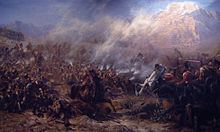4,000 1,770 Date 23 July 1812 | 1,100–1,600 casualties 116–127 casualties Result Anglo-German victory | |
 | ||
Similar Battle of Venta del Pozo, Battle of Maguilla, Battle of Majadahonda, Battle of Arroyo dos Molinos, Battle of Los Yébenes | ||
Battle of garc a hern ndez
In the Battle of García Hernández on 23 July 1812, two brigades of Anglo-German cavalry led by Major-General Eberhardt Otto George von Bock defeated 4,000 French infantry led by Major-General Maximilien Foy. In what would otherwise have been an unremarkable Peninsular War skirmish, the German heavy dragoons achieved the unusual feat of breaking three French squares, those of the 6th, 69th and 76th Line, routing the entire French force with heavy losses.
Contents
Background
The previous day, the Allied army commanded by Arthur Wellesley, 1st Duke of Wellington had won a decisive victory over a French army led by Marshal Auguste Marmont in the Battle of Salamanca. Foy's division was the only French unit not engaged in the battle and it was acting as rearguard on 23 July.
Battle
Bock's 770-strong heavy cavalry brigade, consisting of the 1st and 2nd King's German Legion (KGL) Dragoons, led the pursuit of the French. In support of Bock were the 1,000 troopers of George Anson's British light cavalry brigade (11th and 16th Light Dragoons). As the Anglo-Germans approached, Maj-Gen Curto's French cavalry fled. Foy arranged his eight battalions on a hill in square. He had two battalions each of the 6th Light, and the 39th, 69th and 76th Line Infantry Regiments.
Bock's dragoons charged a square belonging to a battalion of the 6th Light. The French held their fire too long. Their volley killed a number of horsemen, but a mortally wounded horse carrying a dead dragoon crashed into the square like a battering ram. The horse fell, kicking wildly, knocking down at least a half-dozen men and creating a gap in the square. Captain Gleichen rode his horse into the gap, followed by his troopers. The square broke up and most of the men surrendered.
A second square farther up the hillside was soon charged. Shaken by the first square's disaster, the men flinched when the dragoons rode into them. Soon the men in the second square were running for their lives, except those who surrendered. Foy quickly pulled back the rest of his troops. Anson's horsemen mopped up the battlefield.
Results
Foy lost 200 killed and wounded, and 1,400 captured. Bock lost 54 killed and 62 wounded. The very high proportion of killed to wounded was due to the "deadly effect of musketry at the closest possible quarters." Another authority gives 52 Germans killed, 69 wounded and 6 missing and 1,100 total French casualties.
Commentary
The breaking of a steady square was a rare event. A French infantry battalion in square formed up in a bayonet-studded hedgehog either 3-ranks or 6-ranks deep. (A British square was 4-deep.) If a square stood its ground without flinching and fired with effect, it could withstand the best cavalry. When infantry squares were broken by cavalry in the Napoleonic Wars, it was usually because:
At García Hernández, the last event occurred with the first square, leading to the extraordinary accident of a dead horse and rider smashing into the square which was then exploited by the following cavalry. The second square likely panicked at the extraordinary sight of the first square being torn apart.
Marcel was an officer in the 69th Ligne and gives a very different perspective. According to his account (pp170-173) the battalion of the 76th were caught with the men having broken ranks to drink in the stream. The 6th Leger were partially dispersed seeking food in the nearby hamlets with the officers seeking to rally them when they were overtaken by the cavalry. Marcel's battalion was in close column when it was attacked by the cavalry who failed to break the column. The second battalion of the 69th saw off the attacking cavalry by volley fire from its square.
Literature
Culture
This skirmish is depicted in Bernard Cornwell's Novel, Sharpe's Sword.
The battle was also shown in Suzanna Clarke's Jonathan Strange and Mr. Norrell, while Jonathan Strange is serving under the Duke of Wellington.
